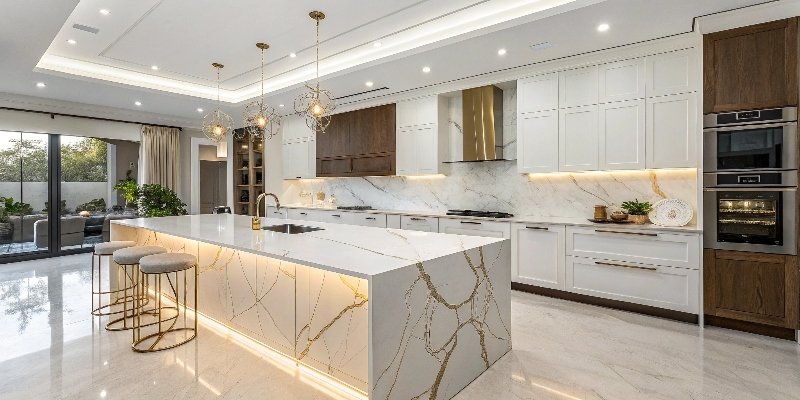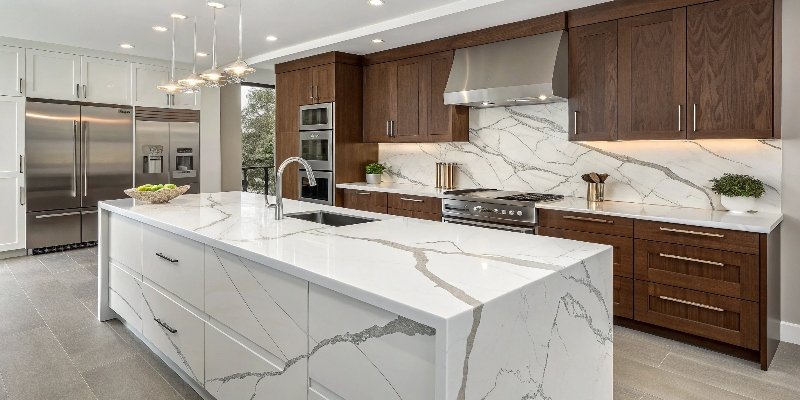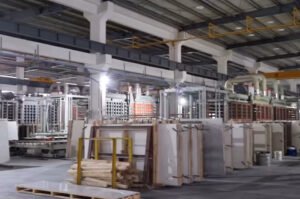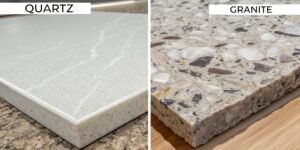Thinking about Calacatta quartz for your project? The term sounds high-end, but this can cause confusion about what it truly is. Let's explore this top-tier design in detail.
Calacatta quartz is an engineered stone designed to replicate famous Italian Calacatta marble. It features a bright white background with thick, dramatic, and flowing veins. This creates a luxurious, high-contrast look that is bold and beautiful, making it a premium choice for countertops and surfaces.

Ah, Calacatta quartz. This is the king of our collection. If quartz designs were cars, Calacatta would be the luxury grand tourer—bold, beautiful, and it always makes a statement. It is one of the most requested styles from discerning clients around the world. But to truly understand what it is, you have to understand the challenge in creating it. It represents the fine line between simple manufacturing and true artistry. It’s our effort to capture the soul of a legendary stone and re-engineer it for modern life.
Is Calacatta quartz high end?
Are you wondering if Calacatta quartz is a genuine luxury product? Choosing a lesser design for a high-end project can disappoint clients. Let me confirm its status in the market.
Yes, Calacatta quartz is considered a high-end, premium product. Its dramatic appearance, complex manufacturing process, and the superior materials required for its creation place it at the top of the quartz market. It delivers a luxurious aesthetic that rivals the world’s finest natural marbles.

The story of how we perfected our Calacatta designs really explains why it’s a high-end product. For years, our early versions were good, but they didn't feel… alive. The veins looked a bit flat, almost like they were printed on. Our top designer, Mr. Wei, was frustrated, saying, "We are copying a picture, not the stone." So, I did something a little crazy. I spent a small fortune to import a single, perfect slab of real Calacatta Oro marble from Italy. We placed this giant, beautiful slab in our R&D workshop.
Mr. Wei studied it for a week. He didn't just photograph it; he analyzed how the main vein was a mix of five or six different shades and how it split into tiny, almost invisible "tributary" veins. Most importantly, he saw how parts of the vein seemed to float just below the surface, creating an incredible illusion of depth. Based on this, we developed a complex, multi-layered production process. It combines machine precision with the skilled hand of a technician to guide the flow of the vein material, replicating that natural randomness. That is what makes it high-end: the art, the investment, and the dedication to capturing the soul of the stone.
Is Calacatta quartz expensive?
Are you worried about the cost of Calacatta quartz? A premium look often comes with a premium price tag. Let's break down why it costs more and the value it provides.
Yes, Calacatta quartz is one of the more expensive quartz options. Its price reflects the higher quality raw materials needed for its pure white base, the complex multi-step manufacturing process to create realistic veins, and the significant research and development investment required to perfect its design.

The higher price of Calacatta quartz is a direct result of the resources needed to create it. It’s not just a simple pattern. First, to get that signature bright, crisp white background, we must use the purest and highest-grade natural quartz crystals. Lower quality quartz has impurities that result in a duller, greyer, or yellowish base. We also use premium-grade resins to ensure clarity and prevent discoloration over time.
Second, the manufacturing process is far more intricate, as I mentioned with Mr. Wei's discovery. Our multi-layered veining technique is slower and requires more skilled labor than producing a simple speckled or monochromatic slab. This increased production time and expertise adds to the cost. Finally, the initial investment in research and development—like when I imported that genuine marble slab from Italy—is factored into the final price. However, it is crucial to compare this to the alternative. Real Calacatta marble can cost three to five times more per square meter, and that is before you even consider the ongoing costs of sealing and maintenance. So, while Calacatta quartz is a premium product, it offers the look of extreme luxury at a fraction of the lifetime cost of the real thing.
Is Calacatta marble or quartzite?
Are you getting confused by the names Calacatta, marble, and quartzite? This common mix-up can lead to costly ordering errors and project delays. Let me help you clearly distinguish between them.
Originally, Calacatta is a famous type of Italian marble. "Calacatta Quartz" is our engineered stone product made to look like that specific marble. It is not quartzite, which is a completely different type of natural stone with a different mineral composition and appearance.

As a procurement manager, using the correct terminology is critical to ensure you get the material you expect. A misunderstanding here can lead to a client receiving a beautiful, but high-maintenance, natural stone when they wanted a durable, engineered one. Let’s break it down clearly.
| Material | Type | Key Characteristics |
|---|---|---|
| Calacatta Marble | Natural Stone | The original. Quarried in Italy. Porous, soft, scratches and stains easily. Very expensive. |
| Calacatta Quartz | Engineered Stone | Our product. Looks like marble but is non-porous, highly durable, and stain-resistant. |
| Quartzite | Natural Stone | Formed from sandstone. Extremely hard and heat-resistant but can be porous and needs sealing. |
The key takeaway is this: "Calacatta" describes a look—a bright white background with dramatic grey or gold veins. You can find this look in very expensive and fragile natural marble. Or you can get the same stunning look in our Calacatta quartz, which is engineered specifically to be strong, durable, and maintenance-free for everyday life. They are not the same material. Always specify "Calacatta Quartz" to ensure you get the performance and durability your project requires.
What are the disadvantages of Calacatta marble?
Are you tempted by the allure of authentic Calacatta marble? Its natural beauty is undeniable, but its significant weaknesses can create a maintenance nightmare for your clients.
The main disadvantages of real Calacatta marble are its softness and porosity. It is a calcium carbonate stone, making it highly susceptible to scratching, chipping, and permanent etching from acids like lemon juice. Its porous nature means it easily absorbs liquids, leading to stubborn stains.

I often tell the story of a meeting with a hotel project team where I demonstrated these disadvantages in real-time. I took a sample of real marble and put a drop of red wine, a bit of lipstick, and some lemon juice on it. After just twenty minutes, the damage was done. The wine had left a permanent stain, and the acid from the lemon had created a dull, rough spot on the polished surface. This is the reality of living with Calacatta marble.
Because it is a relatively soft, calcium-based stone, its problems are inherent to its nature. It is much softer than granite or quartz, so knives can scratch it, and a dropped pot can chip it. Its porosity means it acts like a stone sponge. Spills need to be wiped up immediately, but even then, some liquids can absorb and stain the stone forever. To fight this, it requires professional sealing at least once a year, which is an ongoing maintenance cost. Even with perfect sealing, it is never fully protected from etching. For any high-traffic area like a kitchen or a hotel bathroom, these disadvantages make real Calacatta marble a beautiful but deeply impractical choice for most people.
Conclusion
Calacatta quartz captures the soul of luxury marble. It offers stunning, high-end design without the fragility, making it a wise and practical choice for any demanding and beautiful project.





